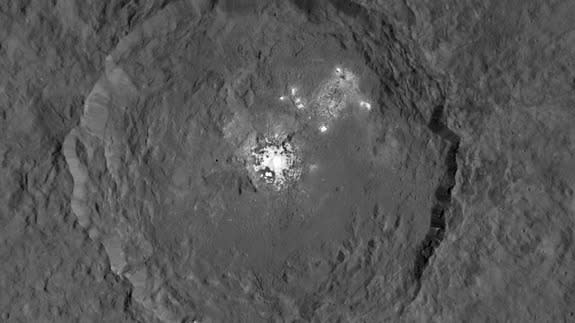Mysterious bright patches on the dwarf planet Ceres may be coming into focus

The mysterious bright spots on the dwarf planet Ceres may be changing, according to a new study published Monday.
A group of scientists using the European Southern Observatory's La Silla Observatory found some preliminary evidence revealing that, as Ceres rotates, its reflective areas seem to brighten and then dim depending on sunlight.
SEE ALSO: Look at this weird mountain rising from the surface of the dwarf planet Ceres
The new finding, gleaned from two nights of observations in 2015, could mean that whatever is creating the reflectivity on the dwarf planet may be evaporating as sunlight hits it.
The findings are detailed in a new study published in the journal Monthly Notices of the Royal Astronomical Society.
In theory, the new observations could mean that when the patches in the Occator crater are hit by sunlight, it creates plumes of reflective material that then evaporates.
"The result was a surprise," Antonino Lanza, co-author of the study, said in a statement.
"We did find the expected changes to the spectrum from the rotation of Ceres, but with considerable other variations from night to night."
At the moment, NASA's Dawn spacecraft is currently orbiting Ceres, getting an up-close look at the dwarf planet's strange features.
The spacecraft recently beamed some data back to Earth showing a detailed view of the bright spots found in the craters.
"As soon as the Dawn spacecraft revealed the mysterious bright spots on the surface of Ceres, I immediately thought of the possible measurable effects from Earth," Paolo Molaro, co-author of the Ceres study, said in the statement.
"As Ceres rotates the spots approach the Earth and then recede again, which affects the spectrum of the reflected sunlight arriving at Earth.”
Scientists have been trying to figure out the composition of the bright spots for years, with greater effort devoted to this task during the past year.
An earlier study suggested that the bright patches in at least one of the craters on the world is made of salt. Other data, including the new study, lend support to the idea that the spots are made of ice.
More data needs to be collected before anyone knows what exactly the spots are made out of.
Unfortunately, it doesn't look like Dawn will be able to confirm the observations detailed in the new study.
"Dawn’s instruments and it’s observing geometry are not optimized to look for such subtle changes as are implied by these ground-based results," Carol Raymond, a scientist working with the Dawn mission, told Mashable via email.
The scientists behind the new research also need many more observations before the new idea is widely accepted.
"Given the tenuous nature of the purported emissions, it will take many followup measurements to make a convincing case for surface changes," Raymond added.


